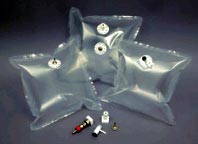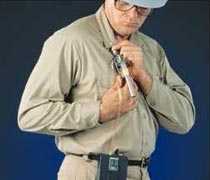All industrial hygiene measurements define potential exposures. There are a variety of industrial hygiene measurements that can be employed and each vary with the types of equipment used for detection, the nature of the sampling, and the amount of time sampled within a work shift. The variety of air sampling techniques provide a professional with a different result applicable to the goal of the air sampling. Let us detail this concept and the different types of samples below.
Grab Sampling
 "Grab" sampling is just that...a short "grab" of air that is analyzed for particular contaminants of interest. This type of sampling provides limited results on "exposure" and is typically incorporated into a qualatative evaluation to establish "presence" or "absence" of a particular contaminant. It is commonly employed in indoor air quality evaluations, post-accident clearance sampling, and presence/absence testing to determine if a contaminant is present during a short process. Equipment used to complete this sampling often includes tedlar bags (to pull air into for laboratory evaluation), drager tubes (drawing air through a detector tube for detection of known contaminants), and direct-reading instruments (to test for presence/absence of contaminants or oxygen content).
"Grab" sampling is just that...a short "grab" of air that is analyzed for particular contaminants of interest. This type of sampling provides limited results on "exposure" and is typically incorporated into a qualatative evaluation to establish "presence" or "absence" of a particular contaminant. It is commonly employed in indoor air quality evaluations, post-accident clearance sampling, and presence/absence testing to determine if a contaminant is present during a short process. Equipment used to complete this sampling often includes tedlar bags (to pull air into for laboratory evaluation), drager tubes (drawing air through a detector tube for detection of known contaminants), and direct-reading instruments (to test for presence/absence of contaminants or oxygen content).
Short-term Exposure Sampling
 Short term sampling is typically conducted over a 15-minute to 30-minute interval within a shift. This sampling is used to define peaks of exposure during a process. The results can be compared to exposure limits that are defined on a short term exposure sample (i.e., short-term exposure limits (STELs) or excursion limits usually 10 - 30 minutes in length). These samples can be completed consecutively (2 or 3 in a row) to see which portion of a particular tasks represents the peak exposure. Equipment used to complete this type of sampling is usually integrated air sampling equipment, direct-reading (with logging and averaging ability), and passive dosimetry.
Short term sampling is typically conducted over a 15-minute to 30-minute interval within a shift. This sampling is used to define peaks of exposure during a process. The results can be compared to exposure limits that are defined on a short term exposure sample (i.e., short-term exposure limits (STELs) or excursion limits usually 10 - 30 minutes in length). These samples can be completed consecutively (2 or 3 in a row) to see which portion of a particular tasks represents the peak exposure. Equipment used to complete this type of sampling is usually integrated air sampling equipment, direct-reading (with logging and averaging ability), and passive dosimetry.
Full-shift Exposure Sampling
Full-shift sampling is typically conducted over an 8-hour shift or the highest anticipated 8-hour exposure period of longer shifts (i.e., 10 and 12 hour shifts). This sampling is used to define the average concentration of the contaminant over the shift and is paramount to personal exposure sampling. These samples can be completed with multilple media with the total sampling time adding up to 8-hours. Equipment used to complete this type of sampling is usually integrated air sampling equipment, direct reading (data logging with averaging ability), and passive dosimetry.

